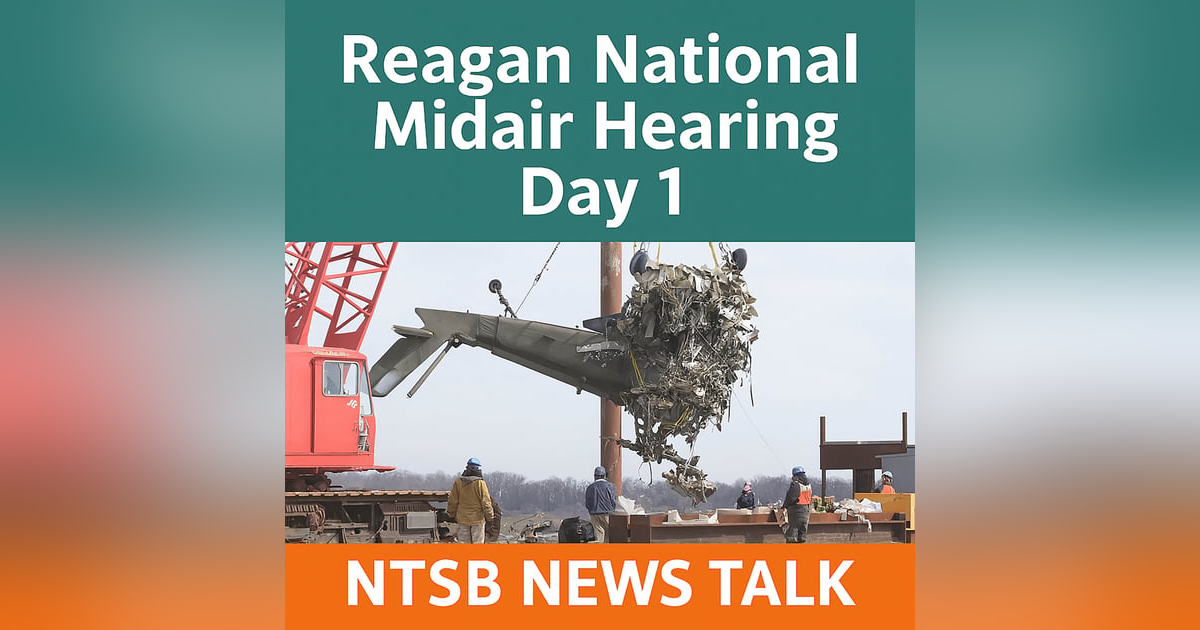Reagan National Midair NTSB Hearing Day 1: Army Black Hawk & Regional Jet Crash Testimony

Max Trescott takes listeners deep inside Day 1 of the NTSB’s investigative hearing into the tragic midair collision near Washington’s Reagan National Airport between a PSA Airlines CRJ-700 and a U.S. Army UH-60L Black Hawk helicopter. The accident claimed the lives of 67 people, including the crew of both aircraft, and has become one of the most scrutinized airspace safety failures in recent history. In this episode of NTSB News Talk, Max distills over ten hours of testimony into 18 critical clips, delivering more than an hour of compelling audio that reveals surprising findings, heated exchanges, and systemic safety issues.
The day opened with an animated reconstruction of the collision showing the helicopter at 280 feet MSL—80 feet above the 200-foot altitude depicted for that segment of the published helicopter route—and the CRJ-700 at 290 feet on short final to DCA’s Runway 33. Panel 1, “Overview of Accident Helicopter’s Air Data Systems and Altimeters,” uncovered a significant problem with UH-60L altimeter accuracy. Test flights conducted after the accident revealed rotor downwash caused barometric altimeters to read 80–130 feet lower than true altitude at hover and cruise. Compounding the issue, transponder encoders legally transmit in 100-foot increments and can be off by up to 90 feet while still being “in spec.” The testimony underscored how cumulative tolerances could create a 100-foot discrepancy between left and right seat altimeters, even with properly maintained systems.
The hearing also exposed a fundamental difference in altitude standards between Army and civilian pilots. Army witnesses stated their standard is to maintain altitude within ±100 feet, meaning 300 feet would still be considered acceptable when targeting 200 feet MSL. Civilian operators, including medevac pilots accustomed to the DCA corridor, testified that in this airspace 200 feet is treated as a hard ceiling, not a target with a tolerance band. This cultural gap framed much of the day’s discussion.
Panel 2, “Overview of the DCA Class B Airspace and Helicopter Routes,” shifted focus to the unique and congested structure of Washington’s helicopter corridors. FAA representatives confirmed a startling fact: the altitudes on the published helicopter charts are “recommended” for VFR operations and are not regulatory unless specifically assigned by ATC. Likewise, drifting off the depicted route or exceeding the published altitude is not a violation unless ATC imposes a hard restriction. Yet multiple witnesses testified that in practice, both Army and civilian pilots, as well as controllers, treat the published routes and altitudes as mandatory. The disconnect between policy and operational understanding drew pointed questioning from the Board.
A recurring theme was the vulnerability of the route structure due to lack of consistent oversight. FAA orders require an annual review of the Baltimore-Washington helicopter route chart, but testimony revealed that DCA Tower has cycled through ten air traffic managers since 2013, with five in the last five years, making continuity of safety evaluations nearly impossible. A working group identified Route 4—the exact route used by the Black Hawk—as hazardous and attempted to mitigate risk by designating charted hotspots. FAA’s Aeronautical Information Services rejected the request on the grounds that “hotspot” symbology is limited to surface charts. NTSB members expressed frustration that bureaucratic charting standards overrode a direct safety recommendation from front-line controllers in the nation’s most complex helicopter environment.
One surprising revelation involved ADS-B compliance. The Army testified that less than 20% of its flights in the region flew with ADS-B Out enabled. Even worse, the investigation discovered that seven of eight Lima-model Black Hawks at Davison Army Airfield were misconfigured and not broadcasting ADS-B Out at all due to maintenance documentation errors during equipment installation. Although the Army issued an immediate safety action message once the problem was discovered, the finding highlights a significant blind spot in surveillance and collision avoidance in one of the busiest mixed-use airspaces in the country.
MedStar’s chief pilot, Rick Dressler, raised another critical point: pilot experience in the National Capital Region. Civilian medevac crews often log thousands of hours flying the DCA corridors over decades, developing an intimate understanding of priorities and flow in the Class B environment. By contrast, Army pilots rotate frequently, often with only a few hundred hours of experience in the airspace, and sometimes exhibit unfamiliarity with medevac priority protocols and heliport coordination. Dressler cited incidents where military helicopters blocked hospital pads, preventing civilian medevac landings with critically ill patients—a chilling illustration of cultural and procedural gaps.
The NTSB also explored training and proficiency, uncovering that aggregate flight hours among Army aviators have been declining for years. Where battalions once had “thousands and thousands” of collective cockpit hours, current totals are “hundreds and hundreds,” with many pilots flying just enough to meet minimum currency requirements rather than achieving deep proficiency. This trend, combined with complex airspace and limited local familiarity, creates layers of risk.
The day concluded with a tense exchange between NTSB Chair Jennifer Homendy and FAA leadership over delays in providing data. Homendy blasted the agency for withholding critical information for six months, only delivering thousands of pages on the Friday before the hearing after intervention from the Secretary of Transportation. Her pointed “Do better” summed up the Board’s frustration with bureaucratic inertia in the face of a catastrophic loss of life.
As Day 2 approaches, focusing on training, guidance, and collision avoidance technology, this episode sets the stage for a deeper understanding of how a confluence of small gaps and misunderstandings led to one of the most devastating midair collisions in recent U.S. aviation history.
Check out our other Aviation News Talk Network podcasts: